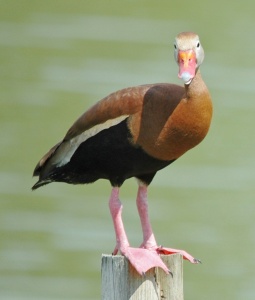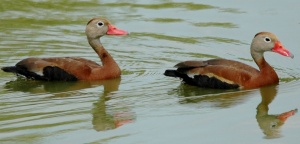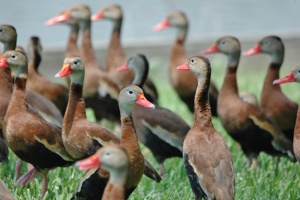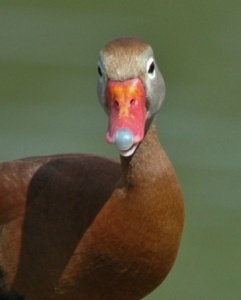The Valley newspapers are regularly filled with local nature articles. From fish to plants to birds.
The South Padre Parade weekly last weekend had an outstanding article on Mexican Black-Bellied Whistling-Ducks, Dendrocygna autumnalis, written by Texas Master Naturalist and Arroyo Colorado Audubon Society member, Marilyn Lorenz, who is a regular birding columnist in local newspapers. Her articles are accompanied by spectacular photographs taken by her husband, Chuck Lorenz.
The Whistlers are really fun ducks. Full of personality and very easy to identify without binoculars.


Many photographers like to photograph wildlife doing something “human.” Whistlers cooperate in that regard.
As a matter of fact, they are so accommodating, I use Mexican Black-bellied Whistling-Duck photo examples in my photo composition workshops in areas such as group shots, portraiture, decisive moment and anthropomorphism.


As Marilyn’s article states, the Whistling-Ducks are clannish. Thus brings some questions for which I continue to research for answers.
My bird guide indicates these ducks are permanent residents, not migratory. For a couple of years, on a Sunday in March we would wake to find 70 Whistlers hanging around on the grass near the Resaca. By Monday morning they would all be gone, except for our few permanent resident ducks.
This year on a Sunday in March, the ducks appeared and were still around the next day, and the next and so on, their numbers increasing little by little until I stopped counting at upwards of 350. They stayed for more than a month and then one day they were gone except for about a dozen ducks. Apparently the time was used as a mass hook-up as the remaining ducks were paired up and now parade their chicks around the Resaca.
My big question is, if they don’t migrate, what are they doing? Are they vagabonds, perhaps just travelling around to different bodies of water searching for a safe and secure party habitat?
Or maybe they vacation. When we lived in Pharr, twice a year the hundreds of permanent-resident Whistlers around the golf course would be gone for about a two-week period. We wouldn’t realize they were gone until we heard the cacophony of their mid-afternoon return.
Now, living on a Resaca outside of San Benito, this year’s huge flock could only be described as one heck of a family reunion.
There is a lot more data on these ducks from a couple years ago when I first formulated all my questions. I now know that the Black-bellied Whistling-Duck is both a migrant and a resident in south Texas. That satisfies that question. The article also explained the March gatherings are the migrants that have wintered in Mexico returning and spreading out over south Texas in late March.
I still wonder how they spread the word as to where to meet for this March fiesta. Another question is what is the silver tip at the end of their bill? Is it some sort of radar like a hurricane-hunter aircraft that helps the ducks with reconnaissance? Probably not, but you never know.

All in all, if one is to have a huge convergence of a form of wildlife, the Whistling-ducks are pretty polite. They don’t trample or eat the grass, they’re relatively quiet and peaceful. They fly into the Resaca so one can mow the grass and they aren’t really messy except for shedding feathers.
They are extremely entertaining and even their inter-personal disputes aren’t frequent nor terribly horrifying. Occasionally one will stretch out its neck and hiss at another Whistler in the group. The opponent generally backs away, much like what they teach in martial arts, which is to escape and run away.
I’d be grateful to hear answers to my questions. In the meantime, look for nature articles in your local press. Chapter members regularly contribute monthly articles to the McAllen Monitor, Valley Morning Star, Coastal Current, South Padre Parade and Welcome Home RGV.

Leave a Reply